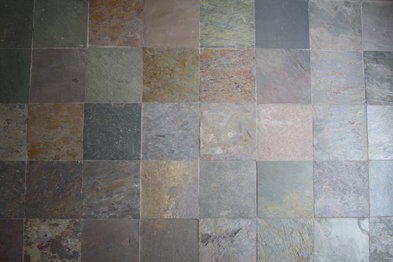Substrate
What We Use
We have NEVER used sand. We used to use Ground Walnut Shells years ago, but after research and speaking with reptile vets and other breeders we saw the potential for impaction was too great as the shells will not be fully digested. Now we use a combination of paper towels and slate tile. Paper towels are great for easy spot cleaning and the slate helps keep their nails trim.
Healthy vs. Pretty
I joke a lot when bringing up this subject because for some reason people get so incredibly defensive about it; as if telling them that a certain substrate they are using is harmful was a personal insult. It amazes me that some people will not even consider other alternatives because they think their enclosure wont look as 'cool' or they are so stubborn and don't want to appear 'wrong' even for the sake of their dragon. The fact is they are not the ones who are 'wrong' they are just uneducated and assume that every bag of substrate at a pet store is safe to use, this sadly could not be further from the truth. And of course it doesn't help that a lot of pet store employees seem to be uneducated themselves. I hope you read this entire page and take from it a realization that a 'pretty' vivarium is less important than a healthy dragon.
Get the Facts
The fact is that a bearded dragon will ingest its substrate to a certain degree. The pieces will get stuck to their food, stick to feeder bugs and will get in their water dish. They will lick substrate either accidentally or on purpose as they use their tongue to help navigate their environment. Sand, among other substrates, will be ingested and cause issues in the digestive tract, eyes and lungs and can kill a dragon. Loose substrates cannot be effectively cleaned and often harbor germs and mites. Would you like to live in a mostly sealed enclosure full of a used cat litter? Neither does your dragon. Loose substrates should not be used, especially with a hatchling or juvenile dragon.
Safer Substrates
Many people have argued this subject with me using the line "they live on sand in the wild". This comment makes me furious. There are birds, snakes and other reptiles that eat dragons in the wild, but you wouldn't put one of those in the enclosure would you? The fact is bearded dragons live on patches of sand and clay in Australian semi-desserts, and eating that in the wild can kill them too. Also did you know that a female dragon can lay up to 150 eggs from a single mating? Why so many? Because in the wild most of them don't make it. They die from many reasons including internal parasites, predators and yes impaction from eating the rocks and dirt on the ground. When you have a captive reptile it now lives under your care and it is your job to make sure it is safe from harm, why intentionally put it in a situation that could be harmful?
Below are substrates I do NOT recommend
***If you decide to use those substrates despite my warnings, please do not feed your dragon in its enclosure to minimize ingestion of these substrates. Though a dragon will still lick and ingest it when exploring and navigating with its tongue. But honestly why risk it?



















